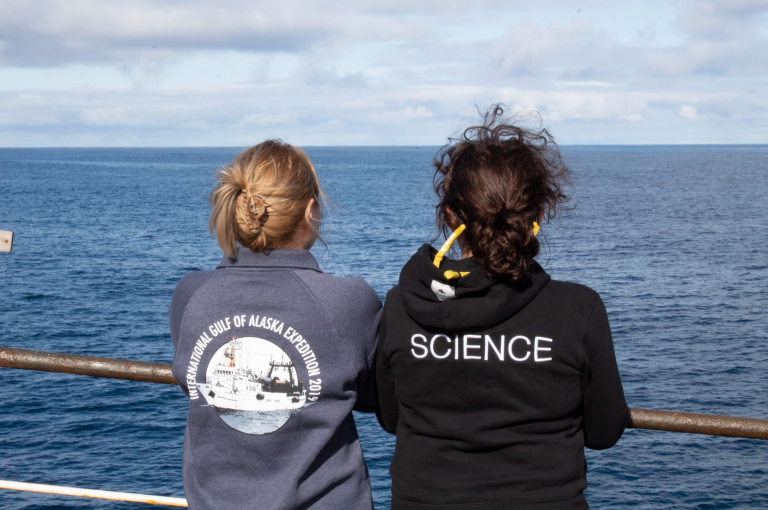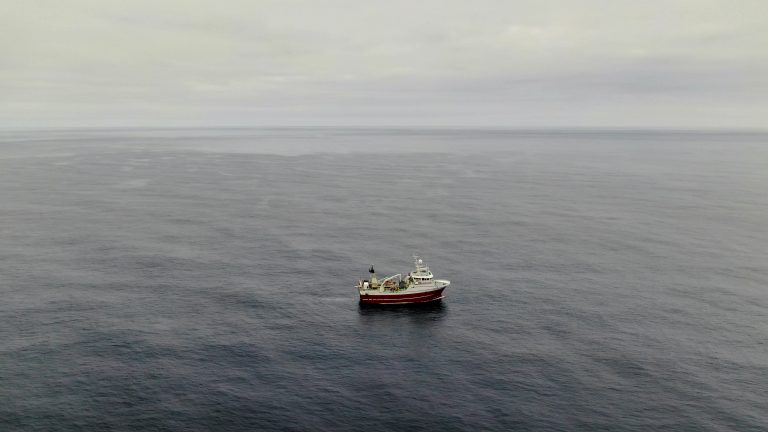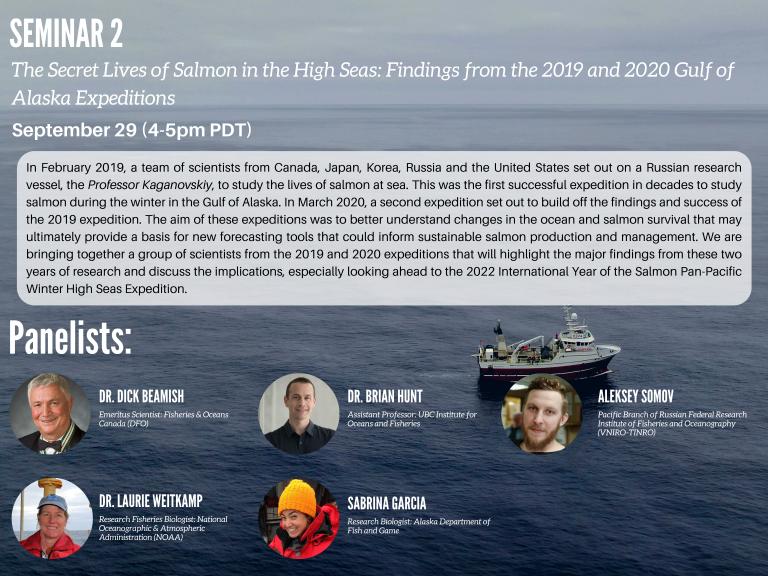The Secret Lives of Salmon in the High Seas: Findings from the 2019 and 2020 Gulf of Alaska Expeditions
MacKenzie Kermoade, NPAFC Intern
Camille Jasinski, IYS Communications Coordinator
November 9, 2021
In September 2021, the International Year of the Salmon (IYS) kicked off its first virtual seminar series: Exploring Frontiers of Salmon Research in Open Ocean Ecosystems. This 7-part series will explore a diverse range of topics leading up to the 2022 IYS Pan-Pacific Winter High Seas Expedition, an international, multi-vessel research expedition surveying the winter ecology of salmon across the North Pacific Ocean. The Pacific Ocean has undergone historic change in the last few decades. While ocean warming events, ocean acidification, and sea level rise, can be attributed to changes in the global climate, the way these changes influence Pacific salmon populations remains a major mystery for salmon scientists. In recent years, some stocks of North Pacific salmon have shown evidence of collapse, while others have returned in record numbers. During the winters of 2019 and 2020, these changes were studied by an international group of researchers during the 2019 and 2020 International Year of the Salmon (IYS) Gulf of Alaska Expeditions.
One of the biggest successes of the 2019 and 2020 Gulf of Alaska Expeditions was its level of international cooperation. Scientists and crew from the five NPAFC member countries — Canada, Japan, Korea, Russia, and the United States — participated in the expeditions, and laid the groundwork for collaborating on the multi-vessel pan-Pacific winter expedition planned for 2022. Moreover, the results of these expeditions have broadened a shared scientific understanding of the mechanisms which regulate Pacific salmon distribution, abundance, and survival in the North Pacific Ocean. On September 29th, 2021, Dr. Dick Beamish (Scientist Emeritus, Fisheries and Oceans Canada), Sabrina Garcia (Alaska Department of Fish and Game), Dr. Brian Hunt (University of British Columbia), Aleksey Somov (Russian Federal Institute of Fisheries and Oceanography), and Dr. Laurie Weitkamp (National Oceanic and Atmospheric Administration) discussed these results during a seminar titled: “The Secret Lives of Salmon in the High Seas: Findings from the 2019 and 2020 Gulf of Alaska Expeditions.” These discussions marked the second event in the ongoing IYS Seminar Series.

The results of the 2019 and 2020 Gulf of Alaska Expeditions were summarized by presenters Dr. Dick Beamish and Dr. Laurie Weitkamp. In both years, researchers recorded physical oceanographic data, deployed plankton nets, and towed trawl nets to capture salmon and other organisms. Dr. Beamish and Dr. Weitkamp highlighted three novel preliminary findings from the 2019 and 2020 survey results. First, the variation in stock origin of coho trawls indicated that coho salmon on the high seas may aggregate into large schools. Second, despite their similar diets, pink and sockeye salmon were rarely captured simultaneously, challenging the theory that inter-specific winter competition accounts for fluctuating sockeye returns. Third, with Canadian sockeye observed in the western of the Gulf of Alaska and Russian sockeye observed in the east, sockeye salmon exhibited a much wider east-west distribution than previously imagined. While requiring further research, these findings enhance our understanding of salmon distribution and behavior during an understudied portion of their lives.
Dr. Beamish emphasized the need to better understand salmon marine survival under rapidly changing ecosystem conditions, and focused on the story of Canadian sockeye. Commercial catches of salmon in BC are at historically low levels, and sockeye returns to the Fraser River have been catastrophically poor — particularly in 2019 and 2020. The Gulf of Alaska Expeditions occurred during the two years that commercial catches and abundance of salmon in the Fraser River were at the lowest point in decades. During their first ocean winter, sockeye salmon spend a short time in coastal areas, move counter–clockwise through the North Pacific, and overwinter in the Gulf of Alaska. Winter ecology surveys in the Gulf of Alaska in 2019 and 2020 showed that sockeye were distributed over a wide area during their first ocean winter, giving scientists a better understanding of where they go in their first ocean year. Scientists can now compare sockeye distributions with data on their prey, such as squid, plankton and jellyfish, to get a better picture of what may have occurred in the record low return years. This will help improve our understanding of how marine survival relates to poor returns for sockeye, exemplifying the utility of the Gulf of Alaska research.

Observations from the 2019 and 2020 Expeditions have still left our panel of scientists with big questions about the distribution, competition, and behavior of salmon on the high seas. The panelists hope to learn whether distribution is driven by biological factors, like prey availability, or by physical factors, like temperature, time of year, or winter sea conditions. Dr. Hunt is concerned with these interconnected components as well as temporal factors — what are salmon doing outside of February and March, and where are they distributed? Dr. Weitkamp wondered about the full geographic breadth of salmon across the North Pacific, and whether distributions might vary by stock as well as species. Both Dr. Weitkamp and Dr. Hunt emphasized the importance of recent advances in our genetic understanding of salmon due to technologies such as environmental DNA (eDNA). eDNA, in combination with trawls and plankton nets, can help us identify the prey, predators and competitors of salmon, and the pressures salmon face in the high seas The researchers hope to better understand salmon diets and behaviors, such as diet variation in wild and hatchery-origin salmon and the prevalence of schooling. Sabrina Garcia also pointed out that one of the biggest unanswered questions concerning salmon in the open ocean is where the survival bottlenecks occur that determine how many salmon will return home to their natal rivers. With various climate events increasing in extremity year after year, finding bottlenecks at various life stages can help inform management actions. Aleksey Somov also underlined the need to understand the severity of winter conditions for salmon survival, as low returns are often attributed to harsh winter conditions with limited evidence.

Although salmon are a resilient group of species, to understand how they will respond to the extreme shifts caused by climate change, it is critical for research efforts to continue. By adopting a full ecosystem approach to data collection, comparing historic and contemporary data sets, and collecting additional years of data, scientists will be better equipped to monitor potential changes in salmon populations
The IYS Pan-Pacific Expedition will run in winter 2022, with an international research team collecting biological and oceanographic data across the North Pacific. You can learn more about the 2022 Pan-Pacific Expedition, as well as the 2019 and 2020 Gulf of Alaska Expeditions, on the IYS Website. You can also follow the IYS as it prepares for the 2022 Expedition by registering for our Seminar Series, “Exploring Frontiers of Salmon Research in Open Ocean Ecosystems.”


